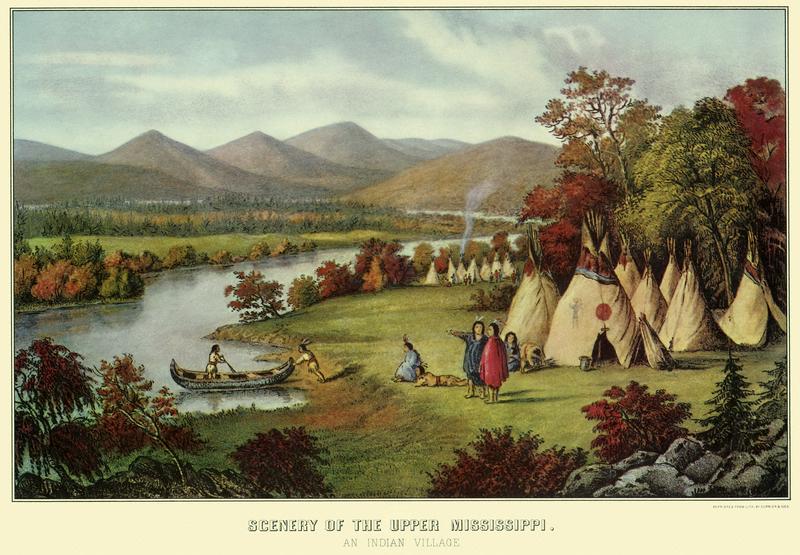The Creek Indians in Georgia
By | January 6, 2019

Creek Indians who had made their home in Georgia, as well as Alabama, were eventually forced out and had to create new lives elsewhere such as Mississippi.
In the Beginning
For reasons not clear, around A.D. 1400, some of the larger tribes disbanded and reformed into smaller tribes throughout the area of the river valleys of Georgia. Possibly, it was because of Spanish invasions and diseases such as smallpox that took out 90 percent of the population. Fortunately, though, the Southeastern tribes began recovering by the end of the 1600s.

In the early 1700s, the Creek Indians occupied more land in Georgia than the colonists and African slaves. By 1760, though, they had become the minority gradually losing land and during the 1800s gave up the rest of their land. Natives from the Ocmulgee River west toward the Coosa and Tallapoosa Rivers in Alabama became united in an effort to build a multifaceted alliance politically. Despite that they spoke different languages, they were united in maintaining peace between each other. The entire united group began to be called “Creek” Indians. The term “Creeks” came from the fact that Indians were living on Ochese Creek near Macon, Georgia, but it ended up becoming a common name for all of the Indians living in the South, which was about 10,000 by 1715.

Traders
Trade became a common interaction between the Creeks and the colonists, which in the beginning involved exchanging slaves and deerskins for textiles and kettles. For a while, there was a practice started by the Creeks that involved capturing and selling Florida Indians but this eventually stopped and deerskins became their main form of trade. By the 1750s, more than 60,000 skins a year were coming out of Charleston, South Carolina, and Savannah, Georgia, which were used for book covers, pants, and gloves. Other items such as cloth, guns, kettles, and rum were also profitable for the Creeks as it became a part of their culture.
Many Georgia traders began settling among the Creeks and even marrying the women and having children. Some of their children became important Creek leaders like William McIntosh and Alexander McGillivray. These leaders helped to persuade the other natives to become a part of the plantation economy. A lot of newcomers to Georgia were African slaves and created ties with the Creek Indians. As a result, during the eighteenth century, there were hundreds of fugitive slaves that had become part of the Creek communities, persuading them to oppose slavery.

When the American Revolution took place between 1775-1783, the Creeks stayed out of the battle. The state of Georgia was not too happy with them and considered their stance against slavery more of an obstacle to their plantation expansion which was more important to them than continuing trade with them. As the pressure was put on them, the Creeks gave up their land that was east of the Ocmulgee River according to three treaties, Treaty of New York in 1790, Treaty of Fort Wilkinson in 1802, and the Treaty of Washington in 1805. Due to the reorganization of the political system that constantly constrained him, Alexander McGillivray became a national leader of the Creeks.

Civil War
Around the same time, the United States created a program for the Creeks that would allow them to become ranchers and planters, which some of them took advantage of but many others did not. By 1813, there was such tension that a civil war broke out between the United States and the Creeks that came to a head in a final battle at Horseshoe Bend, Alabama in March of 1814 when General Andrew Jackson led the slaying of 800 Creeks. It was in August of 1814 that the war was officially over with the Red Stick War that produced the Treaty of Fort Jackson. The Treaty forced the Creeks to give up 22 million acres of land which included a large tract in Southern Georgia.

Another Treaty
In 1825, the Treaty of Indian Springs caused the Creeks to give up what was left of their land. Leader William McIntosh accepted bribes from Georgia agents to sign away all the Creek land in the state and in return, he received plantation land along the Chattahoochee River. The Creeks were none too happy with McIntosh already because he aligned with General Jackson during the Red Stick War so when he accepted this bribe, they voted to have him put to death. The United States rejected the Treaty of Indian Springs but the Creeks knew they were fighting a losing battle with the State of Georgia so they eventually signed the Treaty of Washington giving up the rest of their land.

The Trail of Tears
Not only did Georgia want to take all their land, but they also wanted them to be completely out of Georgia and Alabama altogether. Through the assistance of many citizens of Georgia, 20,000 Creeks were forced to leave Alabama. In 1832, the Creeks agreed to relocate to Indian Territory (Oklahoma) by signing yet another treaty. Unscrupulous land opportunists took advantage of the situation by illegally purchasing lands that belonged to the Creeks and then created antagonism between the whites and the Indians trying to start up another war to get rid of any native residents. They managed to create a conflict in 1836 between the United States and the Creeks which caused the Creeks to be round up and forced to go to Indian Territory. With assistance from Georgia and Alabama military, U.S. troops led by General Winfield Scott sent them away with some even in chains. Consequently, many Creeks were forced to start a new life west of the Mississippi.
The Trail of Tears was the forced removal of not only the Creek Indians but other Indian tribes as well as the Cherokee Indians.

